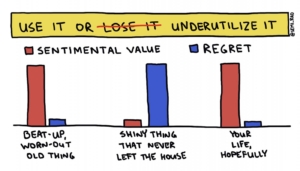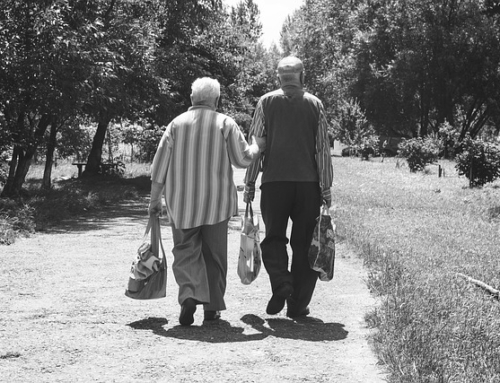By Eddie Pipkin
I said goodbye this week to my old friend, my 2002 Honda Odyssey minivan. It had served me and my family well, veteran of hundreds of road trips, including a few full-on, load-up-the-kids, cross-country journeys. It hauled us all to the Grand Canyon and Yosemite, the Statue of Liberty and the Blue Ridge Parkway. It carried kayaks and bicycles, college dorm furniture, backpacks and beach chairs, crockpots and lumber. It did everything that was asked for it and  then some for 16 years, but finally, after 257,000 miles of memories, it’s time to say goodbye. It actually still runs great—allowing for losing a quart of oil every few days—but now the automatic doors are iffy, the power steering is failing, there’s a short somewhere in the dash, and multiple pieces of trim are held on with duct tape and bungee cords. It has served its purpose nobly, and if I could drive it onto a raft and send it out in a Viking funeral blaze of glory, I’d do it, faithful old friend.
then some for 16 years, but finally, after 257,000 miles of memories, it’s time to say goodbye. It actually still runs great—allowing for losing a quart of oil every few days—but now the automatic doors are iffy, the power steering is failing, there’s a short somewhere in the dash, and multiple pieces of trim are held on with duct tape and bungee cords. It has served its purpose nobly, and if I could drive it onto a raft and send it out in a Viking funeral blaze of glory, I’d do it, faithful old friend.
I have often described it as the most dependable vehicle I have ever owned. I have certainly squeezed every last penny of value out of it. And I am a big, big fan of squeezing the value out of things. This philosophy is the reason that I am part of that quirky crew who are less partial to shiny, new things than we are to well-worn but still functional things. Give me an old Bible that’s marked up with margin notes, a handmade quilt with a hole here and there, or a chipped coffee mug. There is a sense of character and utilitarian value that inhabits things that have been obviously well-used and well-loved.
Brendan Leonard wrote a lovely little essay about this idea recently at Outside Online. It’s called, “The Joy of Wearing Out a Piece of Gear,” and here’s a quote:
Wearing something out gives you a feeling that you’re doing something right. A garage full of gear doesn’t necessarily mean you do anything besides buy gear, but a garage (or closet) full of beat-up stuff means you’re using it, that the dream you had when you acquired that piece of gear was fulfilled in some way. And going through all that dirty, dinged-up, worn-through stuff can be as gratifying as looking through all your old photos of your adventures.
So, here’s a thought for ministry leaders. This should be our attitude about the stuff of ministry: our equipment, our facilities, our supplies, our resources. Our goal should be to wear them out and use them up in pursuit of our goals to serve God and change the world.
Unfortunately, churches are sometimes servants to their facilities rather than the other way around.
We say no to ministry opportunities because they might put the pristine nature of our facilities at risk.
We say no because it is too complex a challenge to figure out how to help disparate groups share rooms and resources, equipment and supplies
We say no because the wear and tear on furniture and vehicles means added expenses and more work. Sometimes we define our ministry health more by the shiny perfection of our spaces, vehicles, ballfields, and supply closets than by the people whose lives are blessed by the wearing and tearing.
Have you experienced:
- Rooms that were off-limits because a particular, sensitive group had defined them as private space or home base?
- Equipment that was hoarded by one ministry area and off-limits to all others?
- Church spaces that were not made available to outside groups because they might mess things up or make that space unavailable for some hypothetical future church use?
- Spaces in the church where children or youth were made to feel unwelcome (even worship spaces)?
- Signs full of “thou shalt nots” that communicate messages to the surrounding community in spaces like parking lots and playgrounds?
I am not advocating throwing open the church doors for any and all activities and people, willy-nilly . . . or maybe I am. What would that church look like? What would its reputation be in the community? Obviously, we have the fiduciary responsibility to protect our facilities and resources, but how many meetings have you sat in for which the protection part was the primary consideration and the use for creative relational ministry part was a distant second. Surely, we can promote respect and good stewardship of our resources while maximizing their potential for robust use. Our goal should be to wear them out. The alternative is the ghost campus of empty, unused buildings that is playing out in too many places.
Jesus’ very example is a life lived to the fullest. His words call us to a  “life lived abundantly” (John 10:10). That is a life (and resources) used fully and with enthusiasm. I love Brendan Leonard’s graphic that he uses to illustrate this idea. It is wonderful visual comparison of the ratio of regret to opportunity. In the context of our available resources (facilities, vehicles, equipment, supplies, staffing and funding), consider these guiding principles:
“life lived abundantly” (John 10:10). That is a life (and resources) used fully and with enthusiasm. I love Brendan Leonard’s graphic that he uses to illustrate this idea. It is wonderful visual comparison of the ratio of regret to opportunity. In the context of our available resources (facilities, vehicles, equipment, supplies, staffing and funding), consider these guiding principles:
- We should leverage our resources, whenever possible, to say yes to ministry.
- In leadership circles (staff and volunteer), we should be clear that our foremost priority is using every available resource to empower ministry vision.
- We should be clear and unified in our ministry vision, so we can be effective in our decision making.
- We should leverage our resources, whenever possible, to say yes to engaging the community beyond our walls.
- We should seek out and encourage partnerships in which outside groups make use of our available resources (particularly our facilities).
- We should remind ourselves that although new ideas and new entanglements use up resources, they also generate excitement and energy that inspire people to donate and serve.
- We should build a culture in which people understand that our resources exist to serve these goals.
- In communications, we should explain our philosophy of how God has called us to use our resources.
- In worship, we should celebrate the ways in which God has empowered us to use our resources.
- Among the many small groups who make up our church family, we should reinforce the joy of sharing space and resources together (and with strangers).
- We should build a culture in which people take pride in good stewardship (even as they are gleefully using up the resources made available to them).
- We should be clear in communicating our expectations of how spaces and resources will be cared for and preserved. We can’t assume people automatically understand what is expected of them. Be clear and be positive (frame “rules” as positives not negatives).
- We should share ownership and responsibilities for shared spaces and resources. Use it together; take care of it together.
- We should give groups opportunities to buy into the renewal of spaces and resources. (Everybody can help paint a new room, chip in for new carpet, and fund raise for a new van.)
- We should remember, as part of this process, that there comes a time to retire the things we have lovingly worn out. Let my old, faithful Odyssey be an example. Everything wears out eventually. Celebrate the purpose it served and take joy in bringing in the new thing.
- This applies equally to programs and events. Just like cars and carpet, programs and events also wear out and wear thin over time. Don’t hold on to sacred cows. Be willing to say goodbye and embrace change. This frees up resources for the next meaningful thing.
One of the keys to a vibrant ministry is a fearless commitment to make maximum use of available resources. What has been your experience in ministry settings whose forward momentum was stymied by an attachment to resources over relationships or, on a more hopeful note, freed to move ahead by a willingness to fully use everything at hand. Share your own stories in the comments section, and then get out there and use today’s resources of time and energy to the max!







Leave A Comment